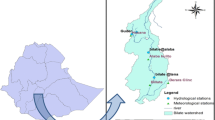Abstract
The main aim of this study was to assess climate change impact on hydrology and water allocation of Megech river sub basin reservoir, Upper Blue Nile Basin, Ethiopia by integrating rainfall runoff HBV-light and Water Evaluation and Planning (WEAP21) model. GCM of the CMIP5 output for RCP2.6, RCP4.5 and RCP8.5 scenarios were obtained from CORDEX-Africa database. The HBV-light model was calibrated and validated to simulate upcoming Megech Reservoir inflow volume and had good performance. WEAP21 was used to assess the water demand requirements, supplied delivered, unmet demand and prepare rule curves for demand sites. The results indicated that the basin average temperature, potential evaporation and open water evaporation would all have increasing trends with pronounced increment in RCP8.5 than RCP4.5 and RCP2.6. However, the inflow volume to the upcoming Megech Reservoir would have decreasing and increasing trend and consistent with precipitation patterns. The total annual water demand requirement was 147.18 Mm3, 179.14 Mm3and 300.44 Mm3 for baseline, lower and higher growth scenarios, respectively. The supply delivered would be 146.92 Mm3 for baseline period and maximum 155.49 Mm3 and minimum 143.77 Mm3 for 2055–2090 under RCP2.6 and RCP8.5, respectively. The annual sum of Megech reservoir capacity under baseline year was 1045.54 Mm3. But it reduced to 570.1955 Mm3, 570.66 Mm3 and 587.59 Mm3 for 2019–2054 period. And also reduced to 448.31 Mm3, 395.88 Mm3 and 383.61 Mm3 for 20552090 demand projection periods under RCP2.6, RCP4.5 and RCP8.5 emission scenarios, respectively. So, in order to guarantee the water resource development project further studies should incorporate impact of land use, sedimentation, adaptation option of climate change, find other supply preference and use crops which have low water requirements.

















Similar content being viewed by others
References
Adeba D, Kansal M, Sen S (2015) Assessment of water scarcity and its impacts on sustainable development in Awash basin, Ethiopia. Sustain Water Resour Manag 1:71–87
Beniston M (2003) Climatic change in mountain regions: a review of possible impacts Climate variability and change in high elevation regions: past, present & future. Springer, Berlin
Gessesse B, Bewket W, Bräuning A (2015) Model-based characterization and monitoring of runoff and soil erosion in response to land use/land cover changes in the Modjo watershed, Ethiopia. Land Degrad Dev 26:711–724
Hargreaves GH, Samani ZA (1985) Reference crop evapotranspiration from temperature. Appl Eng Agric 1:96–99
IPCC (Intergovernmental Panel on Climate Change) (2001) Climate change: the scientific basis. In: Houghton JT, Ding Y, Griggs DJ, Noguer M, van der Linden PJ, Dai X, Maskell K, Johnson CA (eds) Technical summary of the working group I report. Cambridge University Press, Cambridge
IPCC (Intergovernmental Panel on Climate Change) (2007) Climate change 2007: the physical science basis. Contribution of working group II to the fourth assessment report of the Intergovernmental Panel on Climate Change. Cambridge University Press, Cambridge
Jothityangkoon C, Sivapalan M, Viney NR (2000) Tests of a space-time model of daily rainfall in southwestern Australia based on nonhomogeneous random cascades. Water Resour Res 36:267–284
McCartney M, Alemayehu T, Shiferaw A, Awulachew S (2010) Evaluation of current and future water resources development in the Lake Tana Basin. Ethiopia, IWMI
Metz B, Davidson O, Bosch P, Dave R, Meyer L (2007) IPCC, 2007: climate change 2007: mitigation. Contribution of working group III to the fourth assessment report of the intergovernmental panel on climate change. Cambridge University Press, Cambridge
Raes D, Willems P, Gbaguidi F (2006) Rainbow—a software package for hydrometeorological frequency analysis and testing the homogeneity of historical data sets. In: Proceedings of the 4th International Workshop on Sustainable management of marginal drylands. Islamabad, Pakistan, 2006. Citeseer
Razavi T, Coulibaly P (2012) Streamflow prediction in ungauged basins: review of regionalization methods. J Hydrol Eng 18:958–975
Stocker T, Qin D, Plattner G, Tignor M, Allen S, Boschung J, Nauels A, Xia Y, Bex V, Midgley P (2013) IPCC, 2013: summary for policymakers in climate change 2013: the physical science basis, contribution of working group I to the fifth assessment report of the intergovernmental panel on climate change. Cambridge University Press, Cambridge
Tsegaye T, Sheppard D, Islam K, Tadesse W, Atalay A, Marzen L (2006) Development of chemical index as a measure of in-stream water quality in response to land-use and land cover changes. Water Air Soil Pollut 174:161–179
WWDSE T (2008) Lake Tana sub-basin four dams project, final feasibility report for Ribb irrigation project, volume III: hydrological report. Addis Ababa: Water Works Design and Supervision Enterprise and TAHAL
Yates D, Purkey D, Sieber J, Huber-Lee A, Galbraith H (2005) WEAP21—a demand-, priority-, and preference-driven water planning model: part 2: aiding freshwater ecosystem service evaluation. Water Int 30:501–512
Author information
Authors and Affiliations
Corresponding author
Additional information
Publisher's Note
Springer Nature remains neutral with regard to jurisdictional claims in published maps and institutional affiliations.
Rights and permissions
About this article
Cite this article
Asitatikie, A.N., Gebeyehu, W.Z. Assessment of hydrology and optimal water allocation under changing climate conditions: the case of Megech river sub basin reservoir, Upper Blue Nile Basin, Ethiopia. Model. Earth Syst. Environ. 7, 2629–2642 (2021). https://doi.org/10.1007/s40808-020-01024-0
Received:
Accepted:
Published:
Issue Date:
DOI: https://doi.org/10.1007/s40808-020-01024-0




